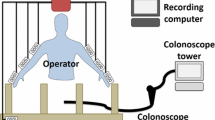Abstract
The control of the conventional flexible endoscope is non-ergonomic and non-intuitive. A novel single-handed interface could reduce the experienced workload, without reducing current efficiency or effectiveness of endoscope manipulation. The aim of this study is to evaluate the workload, efficiency and effectiveness of a single-handed controller in colonoscopy, in comparison to a bimanual controller and the conventional angulation wheels. Twenty-one inexperienced students performed colonoscopies on a computer simulator using either the single-handed controller with a joystick interface, a bimanual controller with a joystick interface or the conventional angulation wheels. Participants performed three sessions of colonoscopies. After each session, the experienced workload was evaluated using a seven-component absolute scoring scale. Efficiency of the procedure was evaluated by the cecal intubation time and total-used scope length. Effectiveness was evaluated by the percentage of bowel wall visualization. The total workload of the single-handed controller was lower compared to the conventional angulation wheels for all three sessions. The total workload of the bimanual controller was lower compared to the conventional angulation wheels in the second and third session and also lower compared to the single-handed controller in the third session. There was no significant difference between the three control interfaces in time efficiency, used scope length or visualization performance. Single-handed and bimanual controllers with a joystick interface are a feasible approach to reduce the workload of colonoscopy without reducing efficiency or effectiveness of endoscope manipulation.





Similar content being viewed by others
Notes
Technical Medicine is a Master’s programme at the University of Twente (The Netherlands) where students integrate advanced technologies with medical sciences to improve patient care.
References
Williams CB (2009) Insertion technique. In: Waye JD, Rex DK, Williams CB (eds) Colonoscopy: principles and practice, 2nd edn. Blackwell Publishing Ltd., London, pp 537–559
Swinnen S, Wenderoth N (2004) Two hands, one brain: cognitive neuroscience of bimanual skill. Trends Cogn Sci 8(1):18–25
Lee S, Chung I, Kim S, Kim J, Ko B, Hwangbo Y, Kim W, Park D, Lee S, Park C, Baek I, Park S, Ji J, Jang B, Jeen Y, Shin J, Byeon J, Eun C, Han D (2008) An adequate level of training for technical competence in screening and diagnostic colonoscopy: a prospective multicenter evaluation of the learning curve. Gastrointest Endosc 67(4):683–689
Sedlack RE (2011) Training to competency in colonoscopy: assessing and defining competency standards. Gastrointest Endosc 74(2):355–366
Shergill A, McQuaid K, Rempel D (2009) Ergonomics and GI endoscopy. Gastrointest Endosc 70(1):145–153
Seeff LC, Richards TB, Shapiro JA, Nadel MR, Manninen DL, Given LS, Dong FB, Winges LD, McKenna MT (2004) How many endoscopies are performed for colorectal cancer screening? Results from CDC’s survey of endoscopic capacity. Gastroenterology 127(6):1670–1677
van Turenhout ST, Terhaar sive Droste JS, Meijer GA, Masclée AA, Mulder CJJ (2012) Anticipating implementation of colorectal cancer screening in The Netherlands: a nation wide survey on endoscopic supply and demand. BMC Cancer 12(1):46
Butterly L, Olenec C, Goodrich M, Carney P, Dietrich A (2007) Colonoscopy demand and capacity in New Hampshire. Am J Prev Med 32(1):25–31
Wallace JE, Lemaire JB, Ghali WA (2009) Review physician wellness: a missing quality indicator. Lancet 374:1714–1721
Klibansky D, Rothstein RI (2012) Robotics in endoscopy. Curr Opin Gastroenterol 28(5):477–482
Stefanidis D, Wang F, Korndorffer JR, Dunne JB, Scott DJ (2010) Robotic assistance improves intracorporeal suturing performance and safety in the operating room while decreasing operator workload. Surg Endosc 24(2):377–382
Hubert N, Gilles M, Desbrosses K, Meyer JP, Felblinger J, Hubert J (2013) Ergonomic assessment of the surgeon’s physical workload during standard and robotic assisted laparoscopic procedures. Int J Med Robot Comput Assist Surg 9:142–147
Ruiter JG, Rozeboom ED, Van der Voort MC, Bonnema GM, Broeders IA (2012) Design and evaluation of robotic steering of a flexible endoscope. In: Proceedings of the IEEE international conference on biomedical robotics and biomechatronics
Rex DK, Petrini JL, Baron TH, Chak A, Cohen J, Deal SE, Hoffman B, Jacobson BC, Mergener K, Petersen BT, a Safdi M, Faigel DO, Pike IM (2006) ASGE quality indicators for colonoscopy. Gastrointest Endosc 63(4 Suppl):S16–S28
Hart SG, California MF, Staveland LE (1988) Development of NASA-TLX (Task Load Index): results of empirical and theoretical research. Adv Psychol 52:139–183
Kuperij N, Reilink R, Schwartz M, Misra S, Stramigioli S, Broeders I (2011) Design of a user interface for intuitive colonoscope control. In: Proceedings of the IEEE/RSJ international conference on intelligent robots and systems (IROS), pp 937–942
Rozeboom ED, Ruiter JG, Franken M, Broeders IA (2014) Intuitive user interfaces increase efficiency in endoscope tip control. Surg Endosc [Epub ahead of print]
Acknowledgments
The authors wish to thank the Departments of Gastrointestinal Endoscopy of the Meander Medical Centre (Amersfoort, The Netherlands) and Ziekenhuisgroep Twente (Hengelo and Almelo) for their clinical input and DEMCON Advanced Mechatronics (Enschede, The Netherlands) for their technical support.
Conflict of interest
E. Rozeboom, Dr. Ir. J. Ruiter, Dr. Ir. M. Franken, M.D. M. Schwartz, Prof. Dr. Ir. S. Stramigioli and Prof. M.D. I. Broeders declare that they have no conflict of interest.
Informed consent
This article does not contain any studies with human or animal subjects performed by any of the authors.
Author information
Authors and Affiliations
Corresponding author
Rights and permissions
About this article
Cite this article
Rozeboom, E.D., Ruiter, J.G., Franken, M. et al. Single-handed controller reduces the workload of flexible endoscopy. J Robotic Surg 8, 319–324 (2014). https://doi.org/10.1007/s11701-014-0473-0
Received:
Accepted:
Published:
Issue Date:
DOI: https://doi.org/10.1007/s11701-014-0473-0




